NVIDIA’s Isaac Gym is your robot training bootcamp in the digital world. Think of it like a massive multiplayer video game where thousands of robot clones learn parkour-level moves without breaking a single circuit. Virtual simulations let robots practice crazy complex movements, from stumbling to recovering, all without real-world repair costs. Want to see how robots might someday move like superheroes? Stick around, and the future might just surprise you.
Understanding Virtual Robotics Simulation
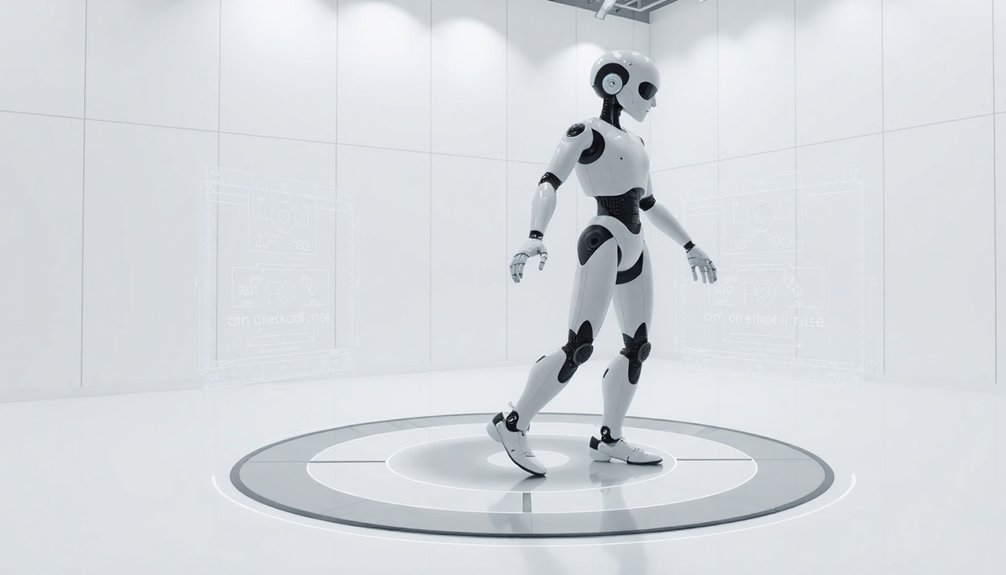
Ever wondered how robots learn to move without breaking themselves or your living room furniture? Enter Isaac Gym, the digital playground where humanoid robots practice their dance moves without risking expensive hardware.
Virtual simulation isn’t just a fancy tech trick—it’s reinforcement learning on steroids. Imagine thousands of robot clones practicing simultaneously in a hyper-realistic digital world, learning complex movements faster than you can say “artificial intelligence.”
Isaac Gym creates environments where robots can fall, stumble, and perfect their techniques without costing a fortune in repairs. This isn’t sci-fi; it’s cutting-edge robotics simulation that trains machines to navigate real-world challenges.
NVIDIA’s Pioneering Simulation Technology
When robotics simulation moves from theoretical playground to industrial powerhouse, NVIDIA steps onto the stage with Isaac Gym—a technological marvel that’s basically a supercharged training ground for robots.
This simulation platform isn’t just another software; it’s a game-changer for humanoid robot learning.
NVIDIA’s breakthrough includes:
- Powering thousands of simultaneous robot training iterations
- Translating virtual skills into real-world robotic movements
- Reducing development time through hyper-efficient simulation techniques
The robot training framework transforms how machines learn, using cutting-edge CUDA and TensorRT technologies to create near-perfect virtual environments.
Imagine teaching a robot complex tasks without risking expensive hardware—that’s the magic of Isaac Gym.
How Isaac Gym Creates Realistic Robot Environments
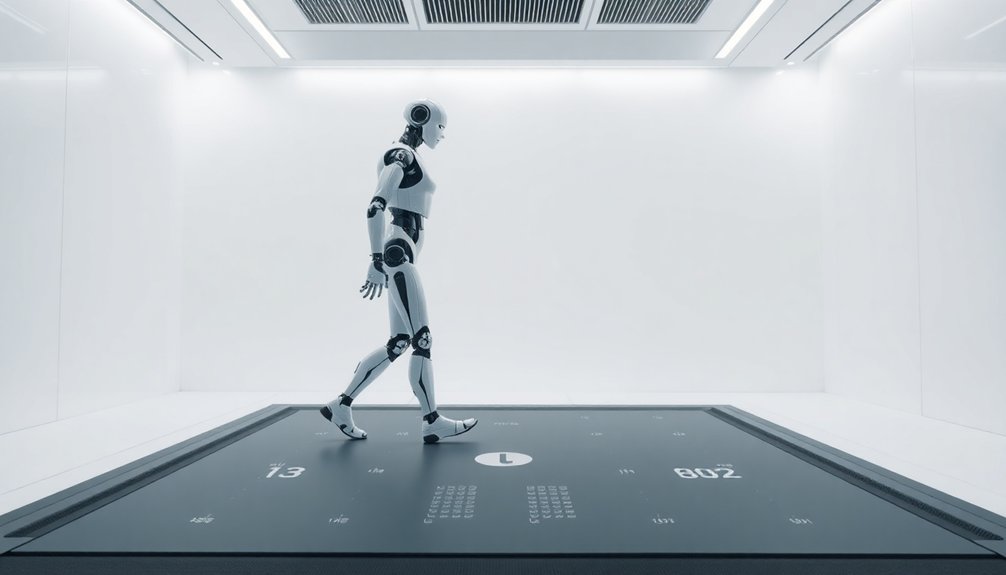
Because simulation isn’t just about pixels and math, Isaac Gym transforms virtual spaces into hyper-realistic robot training grounds that’ll make your engineering brain tingle.
By leveraging NVIDIA’s PhysX physics simulation, this platform crafts environments so real, robots can’t tell they’re not actually bumping into walls or picking up objects.
Want to train a robot to walk? Isaac Gym’s domain randomization throws curveballs like uneven terrain, changing lighting, and unexpected obstacles.
These varied scenarios build robot learning models that won’t panic when real-world conditions get weird. High-fidelity 3D rendering means every surface, texture, and interaction feels authentic.
Reinforcement learning techniques turn these simulated playgrounds into intense training camps where robots learn locomotion, manipulation, and interaction—without risking a single hardware scratch.
Humanoid robots’ machine learning allows these virtual environments to dynamically adjust training scenarios, simulating complex motor skills through neural network processing.
Reinforcement Learning in Robotic Training
You’re watching robots learn like hyper-intelligent toddlers in Isaac Gym’s virtual playground, where reinforcement learning transforms clumsy machines into graceful performers through thousands of simulated trials.
Think of it like a video game where each robot movement gets scored, with successful actions rewarded and awkward stumbles quickly corrected in milliseconds.
Learning Through Simulation
Despite what sci-fi movies might’ve you believe, robots aren’t born knowing kung fu or how to navigate complex environments—they learn, just like humans, but way faster thanks to Isaac Gym’s mind-blowing simulation tech.
In the world of humanoid robots, reinforcement learning has become the secret sauce for training efficiency.
Imagine Isaac Gym as a hyper-realistic video game where robots practice their moves:
- Humanoid robots tumble, recover, and perfect walking in milliseconds
- Virtual environments simulate thousands of scenarios faster than real-world testing
- Algorithms learn and adapt, transforming robotic movements from clunky to graceful
Reinforcement learning in robotics enables advanced humanoid robots to develop sophisticated control systems that replicate human-like movements and decision-making capabilities.
Robot Movement Optimization
When robotic movement meets cutting-edge simulation, magic happens—and Isaac Gym is the wizard behind the curtain. By generating synthetic data through reinforcement learning, the platform transforms humanoid robots from clumsy machines into graceful performers. You’ll watch robots learn complex movements faster than ever before, thanks to parallel simulations that compress training time from days to hours. Adaptive AI frameworks are revolutionizing how robots understand and integrate complex movement patterns across diverse training scenarios.
| Technique | Speed | Efficiency |
|---|---|---|
| Traditional | Slow | Low |
| Isaac Gym | Fast | High |
| Parallel Simulation | Rapid | Ideal |
| Machine Learning | Adaptive | Scalable |
Robot policies developed in Isaac Gym aren’t just theoretical—they’re practical blueprints for real-world performance. Imagine robots learning to dance, navigate obstacles, and adapt in milliseconds. With NVIDIA’s powerful technologies driving these simulations, you’re witnessing the future of robotic intelligence: agile, responsive, and surprisingly human-like.
Reducing Real-World Testing Costs and Risks
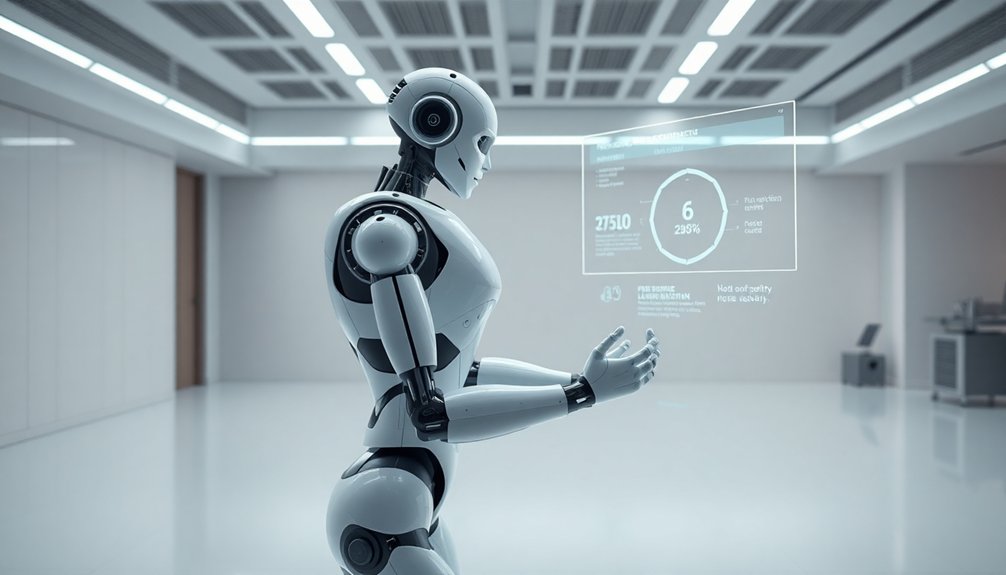
Want to know how robot developers are saving millions without breaking a single prototype?
Isaac Gym lets you run thousands of training scenarios in virtual space, where robots can crash, stumble, and fail spectacularly without costing a dime.
Simulation Cost Efficiency
Imagine slashing robot development costs without sending a single prototype tumbling down a flight of stairs.
Isaac Gym transforms humanoid robot training through virtual simulation, making development incredibly cost-effective. With this digital playground, you’re not just saving money—you’re revolutionizing how robots learn.
- Simulate thousands of training scenarios in hours, not months
- Test risky maneuvers without physical prototype destruction
- Accelerate learning algorithms with zero real-world risk
Companies like FutuRobots are already leveraging advanced simulation technologies to reduce the astronomical costs of humanoid robot development and training.
Safety Through Virtualization
Because traditional robotics testing looks more like a demolition derby than scientific research, Isaac Gym flips the script on safety through virtual simulation.
Imagine training humanoid robots without risking thousands of dollars of expensive hardware or potential mechanical catastrophes. That’s where this platform shines.
By creating hyper-realistic digital environments, Isaac Gym lets developers run countless training scenarios without breaking a single robot or emptying their research budget.
You’ll watch algorithms learn complex movements like sitting and dancing, all while keeping physical robots completely unscathed.
The simulation’s pretrained algorithms dramatically reduce real-world trial and error, meaning safer, smarter robotic development.
Who wouldn’t want a training ground where robot fails are just lines of code instead of expensive mechanical carnage?
Adaptive robotic intelligence enables developers to simulate complex learning scenarios with unprecedented precision and safety.
Physics Simulation and Ground Truth Data
When it comes to training humanoid robots, physics simulation isn’t just a fancy tech trick—it’s the secret sauce that transforms clunky machines into nimble performers.
Isaac Gym turns virtual worlds into robotic boot camps, using NVIDIA® PhysX® to generate ground truth data that’s razor-sharp in accuracy. Your future robot helpers will learn complex moves through thousands of simulated iterations, achieving training efficiency that would make traditional methods look prehistoric.
Imagine robots mastering skills through:
- Walking across uneven terrain without face-planting
- Grasping delicate objects with precision
- maneuvering through obstacle courses like digital ninjas
Virtual simulation isn’t just practice—it’s a quantum leap in humanoid robot development.
Who needs real-world trial and error when you can crash, burn, and restart in milliseconds?
From Simulation to Physical Robot Performance

Physics simulations are cool, but they’re just fancy dress rehearsals until robots can actually strut their stuff in the real world.
Isaac Gym is changing the game by bridging that frustrating gap between virtual training and physical performance. Imagine teaching a humanoid robot complex moves in a simulation, then watching it nail those actions in reality—that’s the magic happening right now.
The GR-2 robot proved this isn’t sci-fi fantasy, scoring an impressive 89% success rate after just 3,000 training iterations. By leveraging optimized inference through NVIDIA’s tech stack, these robots are learning faster and more accurately than ever before.
It’s like turning clunky machine learning experiments into precision dance performances—with robots as the unexpected stars.
AI Model Development Using Synthetic Training
If you’ve ever wondered how robots learn to move without breaking everything in sight, welcome to the wild world of synthetic training.
Isaac Gym transforms AI model development through virtual environments that teach humanoid robots complex movements. It’s like a digital dance studio where robots practice without bruising their metallic knees.
Synthetic training lets you:
- Watch robots master intricate movements in milliseconds
- Reduce real-world testing costs dramatically
- Simulate thousands of scenarios without physical risk
Reinforcement learning algorithms in Isaac Gym enable robots to learn by trial and error—minus the actual broken furniture.
By leveraging advanced simulation techniques, developers can train AI models to perform incredible feats, transferring learned actions from virtual worlds to physical reality with shocking precision.
The future of robotics isn’t just coming; it’s being coded right now.
Advanced Movement Learning for Humanoid Robots
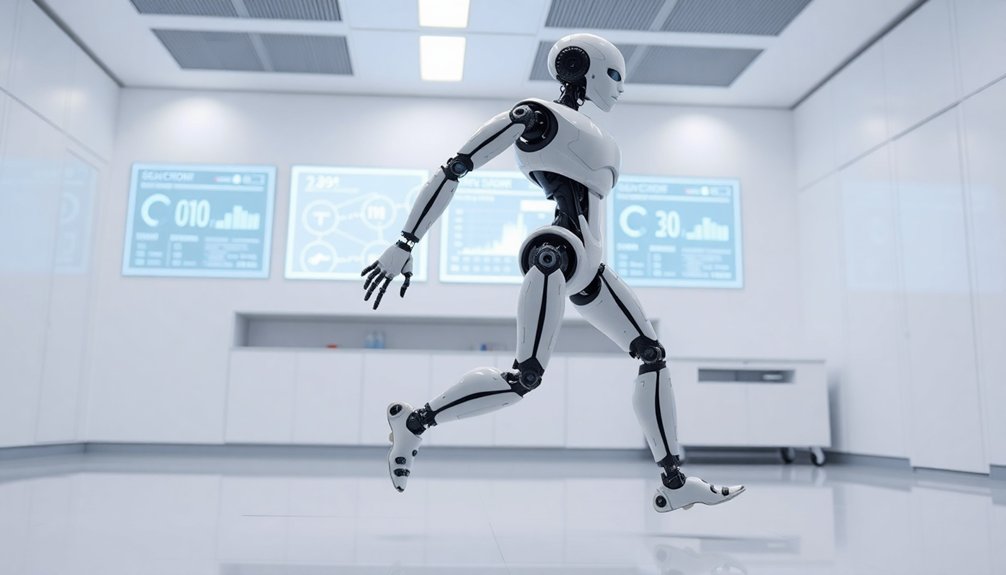
You’ve heard about robots learning to move, but Isaac Gym takes it to another level by turning complex movement into a high-stakes video game of trial and error.
Reinforcement learning dynamics mean these humanoid machines fundamentally “practice” thousands of iterations in virtual space, translating simulated physics into real-world muscle memory faster than you’d think possible.
Reinforcement Learning Dynamics
Because humanoid robots aren’t born knowing how to dance—they’re trained—reinforcement learning has become the secret sauce for teaching machines complex movements.
Isaac Gym transforms this process by creating hyper-realistic virtual environments where robots learn without real-world risks.
Imagine reinforcement learning as robotic boot camp, where humanoid machines practice advanced movements through sim-to-real learning:
- Robots trial thousands of movement iterations in milliseconds
- Virtual physics simulate precise muscle-like tensor translations
- Successful actions get rewarded, unsuccessful ones get optimized
The magic happens when these digital experiments translate to physical performance.
NVIDIA’s technologies like TensorRT and CUDA libraries turbocharge these learning dynamics, allowing humanoid robots to go from awkward beginners to graceful performers with shocking efficiency.
Who said robots can’t learn new tricks?
Simulation-to-Reality Transfer
When humanoid robots learn to move, they don’t just stumble around like toddlers with weird metal limbs—they train in virtual playgrounds that are basically sci-fi boot camps.
Isaac Gym transforms simulation-to-reality transfer into a robotic training ground where complex movements become muscle memory. Imagine thousands of training iterations happening faster than you can blink, where humanoid robotics evolve from clumsy experiments to precision performers.
These virtual environments aren’t just fancy video games—they’re sophisticated learning platforms where robots practice sitting, standing, and dancing without risking a single expensive mechanical scratch.
By mimicking real-world physics with uncanny accuracy, Isaac Gym bridges the gap between digital dreams and physical reality.
Want to watch robots learn? This is how the future gets programmed, one simulated movement at a time.
Industry Applications of Isaac Gym
If robotics had a secret weapon for rapid innovation, Isaac Gym would be that game-changing arsenal. This platform isn’t just another simulator—it’s revolutionizing how humanoid robots learn and adapt through reinforcement learning and virtual simulation.
Imagine training robots without real-world risks:
- Developing complex movement patterns for humanoid robots like GR-2
- Reducing costly physical prototyping through precise virtual environments
- Accelerating robot training from months to mere hours
Isaac Gym transforms robot development by creating hyper-realistic simulations that translate seamlessly into physical performance.
Hyper-realistic simulations are reshaping robotics, bridging virtual training and real-world performance effortlessly.
By running thousands of iterations rapidly, engineers can train robots to perform intricate tasks with unprecedented efficiency.
Who knew robots could learn so quickly without breaking expensive hardware? The future of robotics isn’t just coming—it’s being coded right now, one virtual simulation at a time.
Technical Architecture of Robotic Simulation
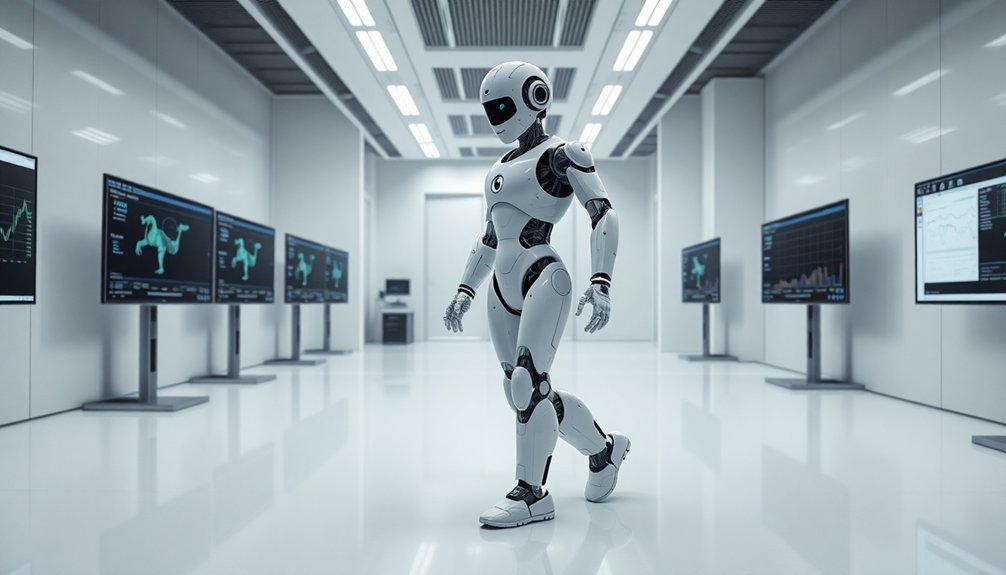
Behind every mind-blowing robot performance lies a digital skeleton key—the technical architecture that enables virtual learning.
Isaac Gym transforms robotic training through its lightning-fast simulation platform. By harnessing NVIDIA GPUs, it runs thousands of humanoid robot scenarios simultaneously—think parallel universes of mechanical learning.
The architecture isn’t just fast; it’s brutally efficient. Reinforcement learning gets supercharged as robots practice complex movements in hyper-realistic digital environments.
Imagine a humanoid robot practicing parkour, falling thousands of times per second without breaking a single real-world bone. Domain randomization throws curveballs into these simulations, creating unpredictable training scenarios that forge more adaptable AI.
It’s like robot boot camp, but instead of drill sergeants, you’ve got algorithms pushing mechanical limits. Who said learning to walk was hard?
Future of Robot Training and Development
Because the robotics landscape is evolving faster than a caffeinated cheetah, the future of robot training looks less like sterile laboratories and more like high-stakes video game development.
Isaac Gym is transforming how we prep humanoid robots for real-world challenges through sim-to-real learning, making robot training workflows feel like digital bootcamps.
Imagine training robots where:
- Thousands of virtual scenarios play out simultaneously, like parallel universe experiments
- Reinforcement learning algorithms learn complex movements in milliseconds
- Robotic agents adapt and improve faster than you can say “artificial intelligence”
The platform’s cloud-native capabilities and parallel processing mean humanoid robots will soon move with a grace that’ll make Olympic gymnasts look like awkward toddlers.
Who’s ready for the robot revolution?
People Also Ask About Robots
What Is the Isaac Sim Used For?
You’ll use Isaac Sim to generate synthetic data for robotics training, simulate realistic physics interactions, test robotic systems safely, and validate software-in-the-loop before deploying robots in autonomous vehicle and industrial automation applications.
What Is Isaac Gym?
Isaac Gym’s a powerful NVIDIA robotics simulation platform that’ll help you develop and train complex robotic movements through advanced reinforcement learning, enabling efficient virtual testing and realistic skill transfer to physical robot systems.
How to Train Humanoid Robots?
You’ll revolutionize robotics by mastering reinforcement learning! Use NVIDIA Isaac Gym to simulate complex movements, train your humanoid through thousands of iterations, and optimize physical skills with advanced machine learning techniques.
Is the NVIDIA Isaac SIM Free to Use?
Yes, you’ll find Isaac Sim is free for individual developers and researchers. However, if you’re planning to distribute applications built with it, you’ll need to obtain an Omniverse Enterprise license.
Why This Matters in Robotics
Virtual robots aren’t sci-fi anymore—they’re learning faster than you can imagine. With Isaac Gym, AI’s reshaping how machines understand movement, potentially reducing robotic training costs by up to 90%. You’re witnessing the dawn of intelligent machines that’ll transform industries from manufacturing to space exploration. The future isn’t just coming; it’s being coded right now, one simulated step at a time.
